Investigation of Micromechanical Properties and Tribological Behavior of WE43 Magnesium Alloy after Deep Cryogenic Treatment Combined with Precipitation Hardening
Abstract
:1. Introduction
2. Materials and Methods
- Load—Fn: 10 (N)
- Friction distance radius—r: 7 (mm)
- Linear velocity—v: 0.15 (m/s)
- Distance—s: 100 (m)
- Ambient temperature: 21 ± 1 (°C)
- Air humidity: 40% ± 5 (%)
3. Research Results and Discussion
3.1. Micromechanical Tests
3.2. Sliding Wear Tests on WE43 Magnesium Alloy
3.3. Determination of Wear Micromechanisms of WE43 Alloy in Rotary Motion
4. Conclusions
- Deep cryogenic treatment (DCT) combined with precipitation hardening by changing the structure effectively improves the micromechanical and tribological properties of alloy WE43. Among others, a more than 15% increase in hardness HIT and Young’s modulus EIT, as well as a change in parameters such as maximum indenter penetration depth, surface area and indent volume were demonstrated. The lowest values of total indentation work Wtot were observed with an about 14% share of elastic deformation work ηIT.
- As the maximum indenter load Fmax increased, a considerable decrease in the micromechanical properties (HIT, EIT) was observed, which indicates a strong effect of the increase in the surface area of the indents made on the WE43 magnesium alloy on the values measured by means of microindentation. The measurements showed a small scatter of results, 3% on average, and dependence of the tested quantities on the applied heat treatment was preserved for all loads.
- The tribological tests and the parameters tested, such as: volumetric wear Vw, linear wear Lw and stabilized friction coefficient μmean, indicate a twofold improvement in wear resistance of WE43 magnesium alloy subjected to deep cryogenic treatment in combination with precipitation hardening, compared to the alloy in the as-delivered condition.
- Profilometric studies, microscopic observation and microanalysis of the chemical composition (EDS) showed that the proposed treatment (DCT + precipitation hardening) is effective in reducing the area (depth and width) of the wear traces of the magnesium-rare earth alloy and reduces the cutting process as well as the adhesion of alloy material to counter-specimens, i.e., ZrO2 balls, The heat treatment applied and the friction process itself have no significant effect on the change in alloy composition.
- The examination of the morphology of the wear traces allows for the conclusion that abrasive wear was the main wear mechanism of the WE43 alloy. The SEM images showed phenomena characteristic of this wear mechanism, such as microploughing, microcutting and adhesion.
- Further research is being conducted to understand the exact mechanism affecting the improvement of properties of magnesium alloys with rare earth metals under deep cryogenic treatment. The combination of deep cryogenic treatment and precipitation hardening is an effective method to improve the service life of WE43 magnesium alloy.
Author Contributions
Funding
Institutional Review Board Statement
Informed Consent Statement
Data Availability Statement
Conflicts of Interest
References
- Kainer, K.U. Magnesium Alloys and Technologies; Wiley-Vch: Weinheim, Germany, 2003; ISBN 9783527305704. [Google Scholar]
- Mordike, B.; Ebert, T. Magnesium: Properties—Applications—Potential. Mater. Sci. Eng. A 2001, 302, 37–45. [Google Scholar] [CrossRef]
- You, S.H.; Huang, Y.D.; Kainer, K.U.; Hort, N. Recent research and developments on wrought magnesium alloys. J. Magnes. Alloy. 2017, 5, 239–253. [Google Scholar] [CrossRef]
- Zeng, Z.; Stanford, N.; Davies, C.H.J.; Nie, J.F.; Birbilis, N. Magnesium extrusion alloys: A review of developments and prospects. Int. Mater. Rev. 2019, 64, 27–62. [Google Scholar] [CrossRef]
- Pan, H.C.; Ren, Y.P.; Fe, H.; Zhao, H.; Wang, L.Q.; Meng, X.Y.; Qin, G.W. Recent developments in rare-earth free wrought magnesium alloys having high strength: A review. J. Alloy. Compd. 2016, 663, 321–331. [Google Scholar] [CrossRef]
- Witte, F.; Kaese, V.; Haferkamp, H.; Switzer, E.; Meyer-Lindenberg, A.; Wirth, C.; Windhagen, H. In vivo corrosion of four magnesium alloys and the associated bone response. Biomaterials 2005, 26, 3557–3563. [Google Scholar] [CrossRef] [PubMed]
- Naqvi, R.B.; Joya, Y.F.; Karim, M.R.A. Next-generation biomaterials for bone-tissue regeneration: Mg-Alloys on the move. Key Eng. Mater. 2018, 778, 306–315. [Google Scholar] [CrossRef] [Green Version]
- Pruitt, L.A.; Chakravartula, A.M. Mechanics of Biomaterials: Fundamental Principles for Implant Design; Cambridge University Press: Cambridge, UK, 2011; ISBN 9780521762212. [Google Scholar]
- Nagels, J.; Stokdijk, M.; Rozing, P.M. Stress shielding and bone resorption in shoulder arthroplasty. J. Shoulder Elb. Surg. 2003, 12, 35–39. [Google Scholar] [CrossRef]
- Riggs, B.L.; Melton, L.J., III. The worldwide problem of osteoporosis: Insights afforded by epidemiology. Bone 1995, 17, 505–511. [Google Scholar] [CrossRef]
- Purusothaman, M.; Sasikumar, M. Processing/properties and applications of Magnesium based metal matrix composites: A review. Internat. J. Intellect. Advanc. Resear. Engineer. Computat. 2017, 5, 1995–2007. [Google Scholar]
- Krause, A.; Von Der Höh, N.; Bormann, D.; Krause, C.; Bach, F.-W.; Windhagen, H.; Meyer-Lindenberg, A. Degradation behaviour and mechanical properties of magnesium implants in rabbit tibiae. J. Mater. Sci. 2010, 45, 624–632. [Google Scholar] [CrossRef]
- Hort, N.; Huang, Y.D.; Fechner, D.; Störmer, M.; Blawert, C.; Witte, F.; Vogt, C.; Drücker, H.; Willumeit, R.; Kainer, K.U.; et al. Magnesium alloys as implant materials—principles of property design for Mg-RE alloys. Acta Biomater. 2010, 6, 1714–1725. [Google Scholar] [CrossRef] [PubMed] [Green Version]
- Barylski, A.; Kupka, M.; Aniołek, K.; Rak, J. The effect of precipitation hardening on the structure and mechanical and tribological properties of magnesium alloy WE54. Vacuum 2017, 139, 77–86. [Google Scholar] [CrossRef]
- Sonar, T.; Lomte, S.; Gogte, C. Cryogenic Treatment of Metal—A Review. Mater. Today Proc. 2018, 5, 25219–25228. [Google Scholar] [CrossRef]
- Öteyaka, M.Ö.; Karahisar, B.; Öteyaka, H.C. The Impact of Solution Treatment Time (T6) and Deep Cryogenic Treatment on the Microstructure and Wear Performance of Magnesium Alloy AZ91. J. Mater. Eng. Perform. 2020, 29, 5995–6001. [Google Scholar] [CrossRef]
- Preciado, M.; Bravo, P.M.; Alegre, J.M. Effect of Low Temperature Tempering Prior Cryogenic Treatment on Carburized Steels. J. Mater. Process. Technol. 2006, 176, 41–44. [Google Scholar] [CrossRef]
- Mohan Lal, D.; Renganarayanan, S.; Kalanidhi, A. Cryogenic Treatment to Augment Wear Resistance of Tool and Die Steels. Cryogenics 2001, 41, 149–155. [Google Scholar] [CrossRef]
- Da Silva, F.J.; Franco, S.D.; Machado, Á.R.; Ezugwu, E.O.; Souza, A.M. Performance of cryogenically treated HSS tools. Wear 2006, 261, 674–685. [Google Scholar] [CrossRef]
- Liu, J.; Li, G.; Chen, D.; Chen, Z. Effect of Cryogenic Treatment on Deformation Behavior of As-cast AZ91 Mg Alloy. Chin. J. Aeronaut. 2012, 25, 931–936. [Google Scholar] [CrossRef] [Green Version]
- Amini, K.; Akhbarizadeh, A.; Javadpour, S. Investigating the Effect of Quench Environment and Deep Cryogenic Treatment on the Wear Behavior of AZ91. Mater. Des. 2014, 54, 154–160. [Google Scholar] [CrossRef]
- Liu, Y.; Shao, S.; Xu, C.; Yang, X.; Lu, D. Enhancing wear resistance of Mg-Zn-Gd alloy by cryogenic treatment. Mater. Lett. 2012, 76, 201–204. [Google Scholar] [CrossRef]
- Liu, Y.; Jin, B.; Shao, S.; Li, D.; Zeng, X.; Xu, C. Dry Sliding Wear Behavior of Mg-Zn-Gd Alloy before and after Cryogenic Treatment. Tribol. Trans. 2014, 57, 275–282. [Google Scholar] [CrossRef]
- Yuan, J.; Li, T.; Zhang, K.; Li, X.; Li, Y.; Ma, M.; Shi, G.; Du, Z.; Liu, W.; Peng, Y. Precipitation Behavior of Mg-7Gd-3Y-2Zn-0.5Zr Alloy during Isothermal Aging. Materials 2021, 14, 1737. [Google Scholar] [CrossRef]
- Rong, W.; Wu, Y.; Zhang, Y.; Sun, M.; Chen, J.; Peng, L.; Ding, W. Characterization and strengthening effects of γ′ precipitates in a high-strength casting Mg-15Gd-1Zn-0.4Zr (wt.%) alloy. Mater. Charact. 2017, 126, 1–9. [Google Scholar] [CrossRef]
- Liu, W.; Du, Z.-W.; Li, T.; Zhang, K.; Han, X.-L.; Peng, Y.-G.; Zhang, J.; Yuan, J.-W.; Liu, S.-F.; Pang, Z. Precipitate evolution in Mg−7Gd−3Y−1Nd−1Zn−0.5Zr alloy during isothermal ageing at 240 °C. Trans. Nonferrous Met. Soc. China 2019, 29, 2047–2055. [Google Scholar] [CrossRef]
- Barylski, A.; Aniołek, K.; Dercz, G.; Kupka, M.; Kaptacz, S. The effect of deep cryogenic treatment and precipitation hardening on the structure, micromechanical properties and wear of the Mg-Y-Nd-Zr alloy. Wear 2020, 468, 203587. [Google Scholar] [CrossRef]
- Barylski, A.; Aniołek, K.; Dercz, G.; Kupka, M.; Matuła, I.; Kaptacz, S. The Sclerometrical, Mechanical, and Wear Behavior of Mg-Y-Nd Magnesium Alloy after Deep Cryogenic Treatment Combined with Heat Treatment. Materials 2021, 14, 1218. [Google Scholar] [CrossRef]
- ISO. Metallic Materials—Instrumented Indentation Test for Hardness and Materials Parameters—Part 1: Test Method; ISO 14577-1:2015; ISO: Geneva, Switzerland, 2015. [Google Scholar]
- Oliver, W.C.; Pharr, G.M. An improved technique for determining hardness and elastic modulus using load and displacement sensing indentation experiments. J. Mater. Res. 1992, 7, 1564–1583. [Google Scholar] [CrossRef]
- Ma, Q.; Clarke, D.R. Size dependent hardness of silver single crystals. J. Mater. Res. 1995, 10, 853–863. [Google Scholar] [CrossRef]
- ASTM G99-17. Standard Test Method for Wear Testing with a Pin-on-Disk Apparatus; ASTM International: West Conshohocken, PA, USA, 2017. [Google Scholar]
- Asl, K.M.; Tari, A.; Khomamizadeh, F. Effect of deep cryogenic treatment on microstructure, creep and wear behaviors of AZ91 magnesium alloy. Mater. Sci. Eng. A 2009, 523, 27–31. [Google Scholar] [CrossRef]
- Liu, Y.; Shao, S.; Xu, C.S.; Zeng, X.S.; Yang, X.J. Effect of cryogenic treatment on the microstructure and mechanical properties of Mg-1.5Zn-0.15Gd magnesium alloy. Mater. Sci. Eng. A 2013, 588, 76–81. [Google Scholar] [CrossRef]
- Nix, W.D.; Gao, H. Indentation size effects in crystalline materials: A law for strain gradient plasticity. J. Mech. Phys. Solids 1998, 46, 411–425. [Google Scholar] [CrossRef]
- Mondal, A.K.; Kumar, S. Dry sliding wear behavior of magnesium alloy based hybrid composites in the longitudinal direction. Wear 2009, 267, 458–466. [Google Scholar] [CrossRef]
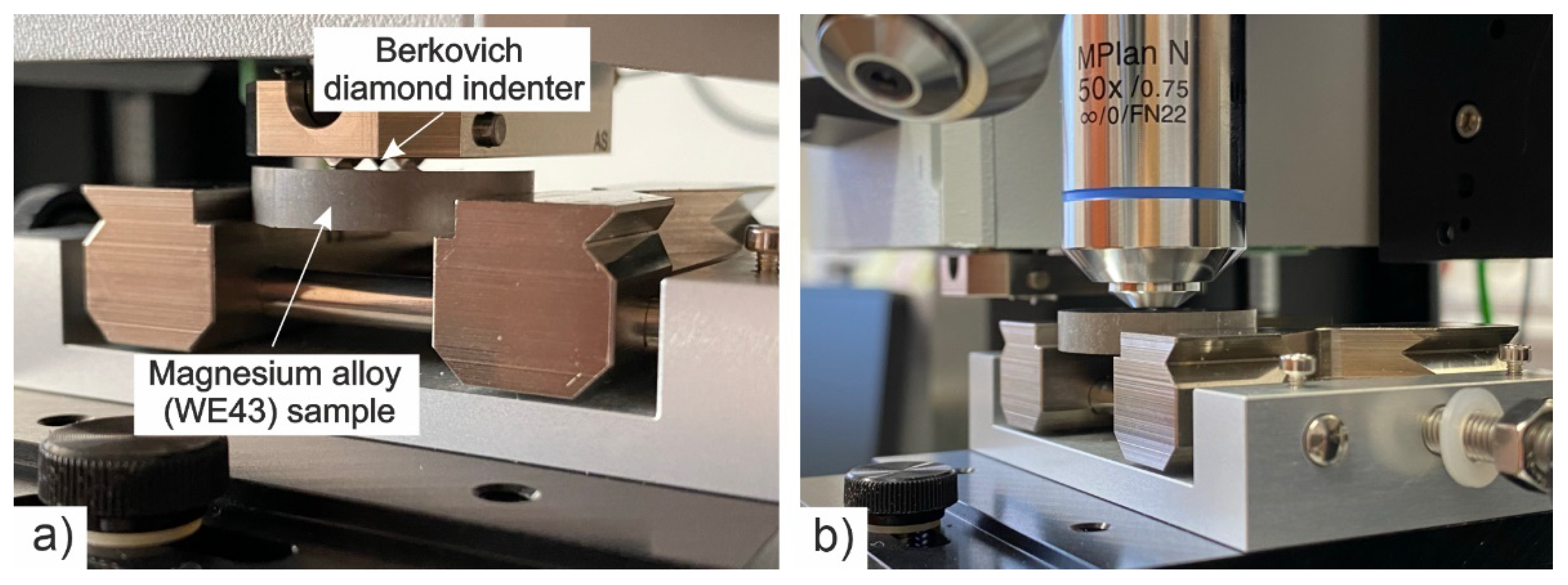
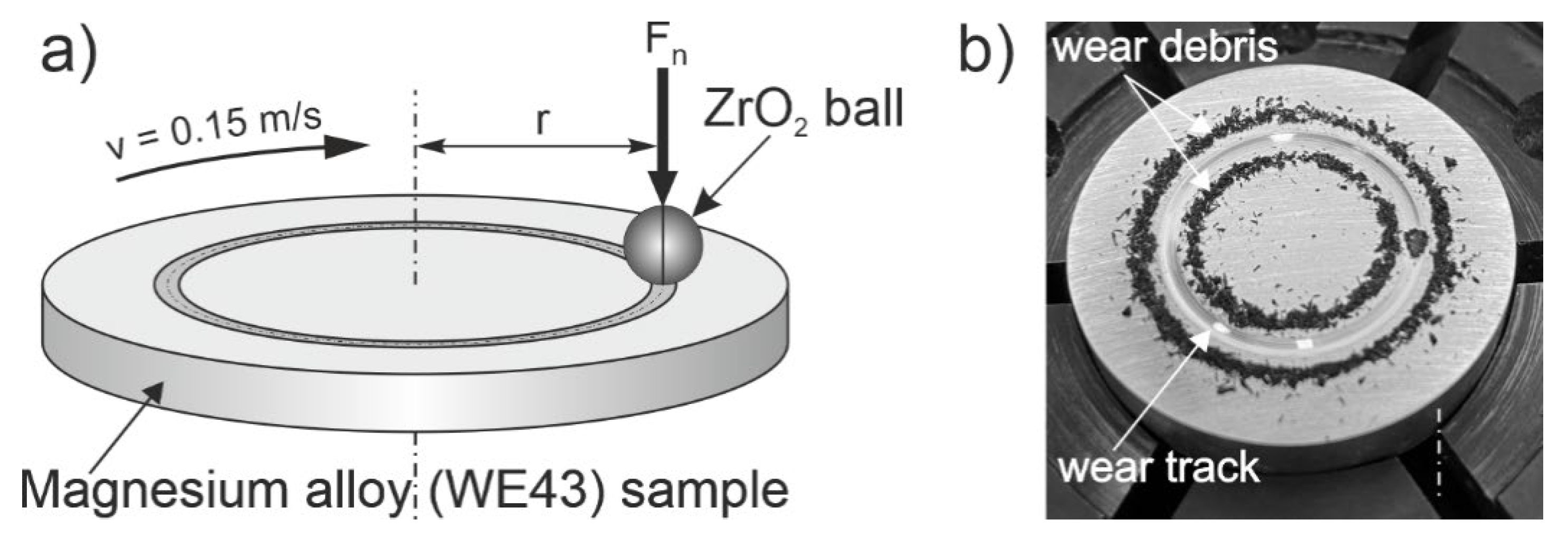
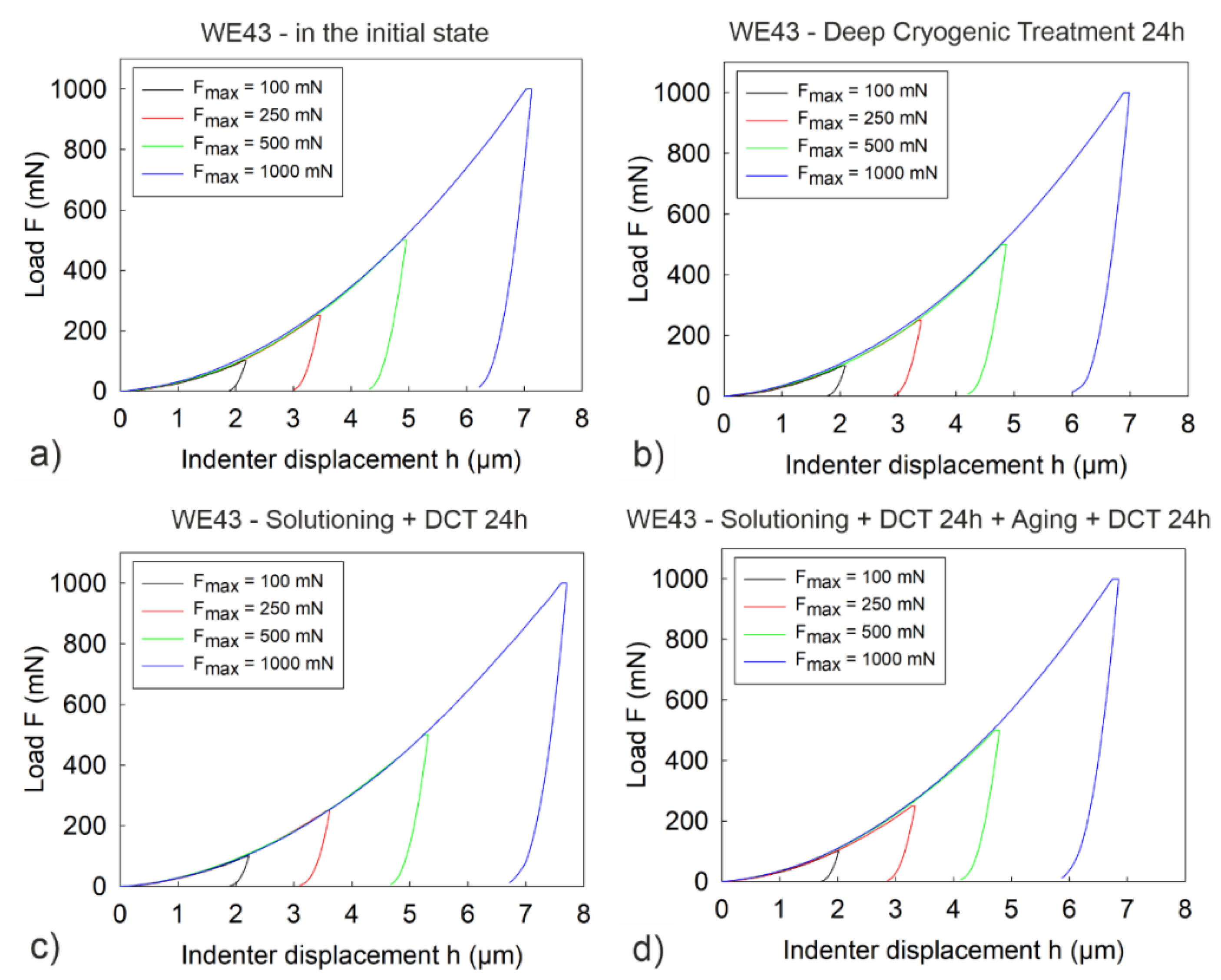


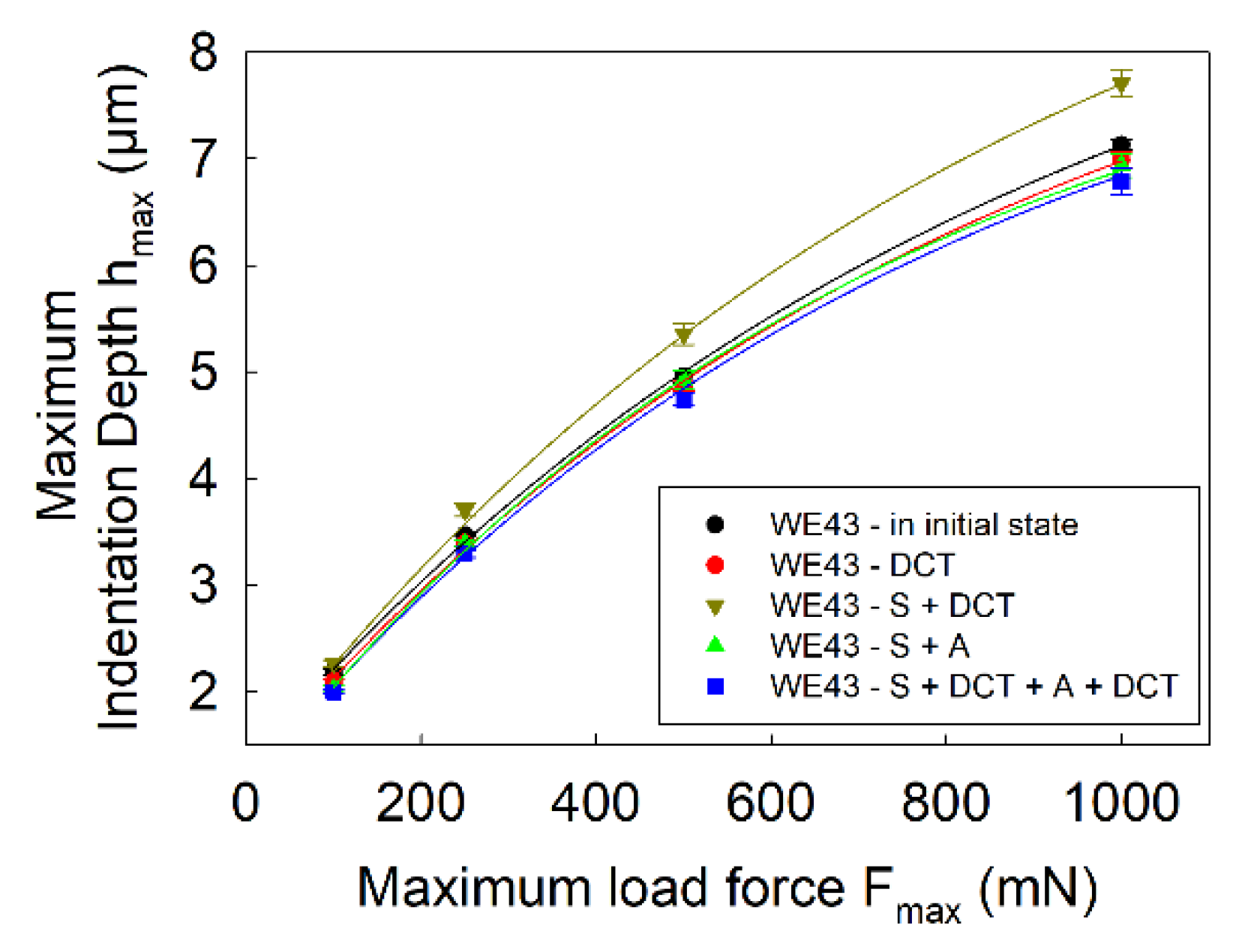
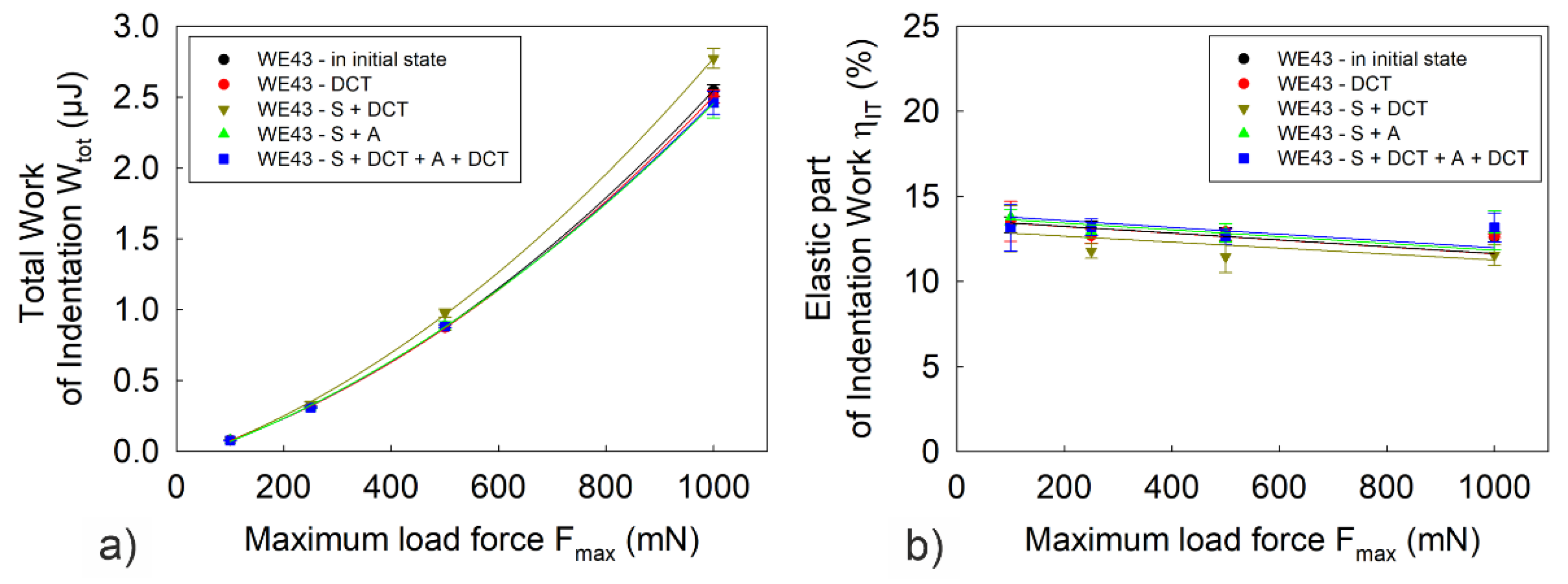
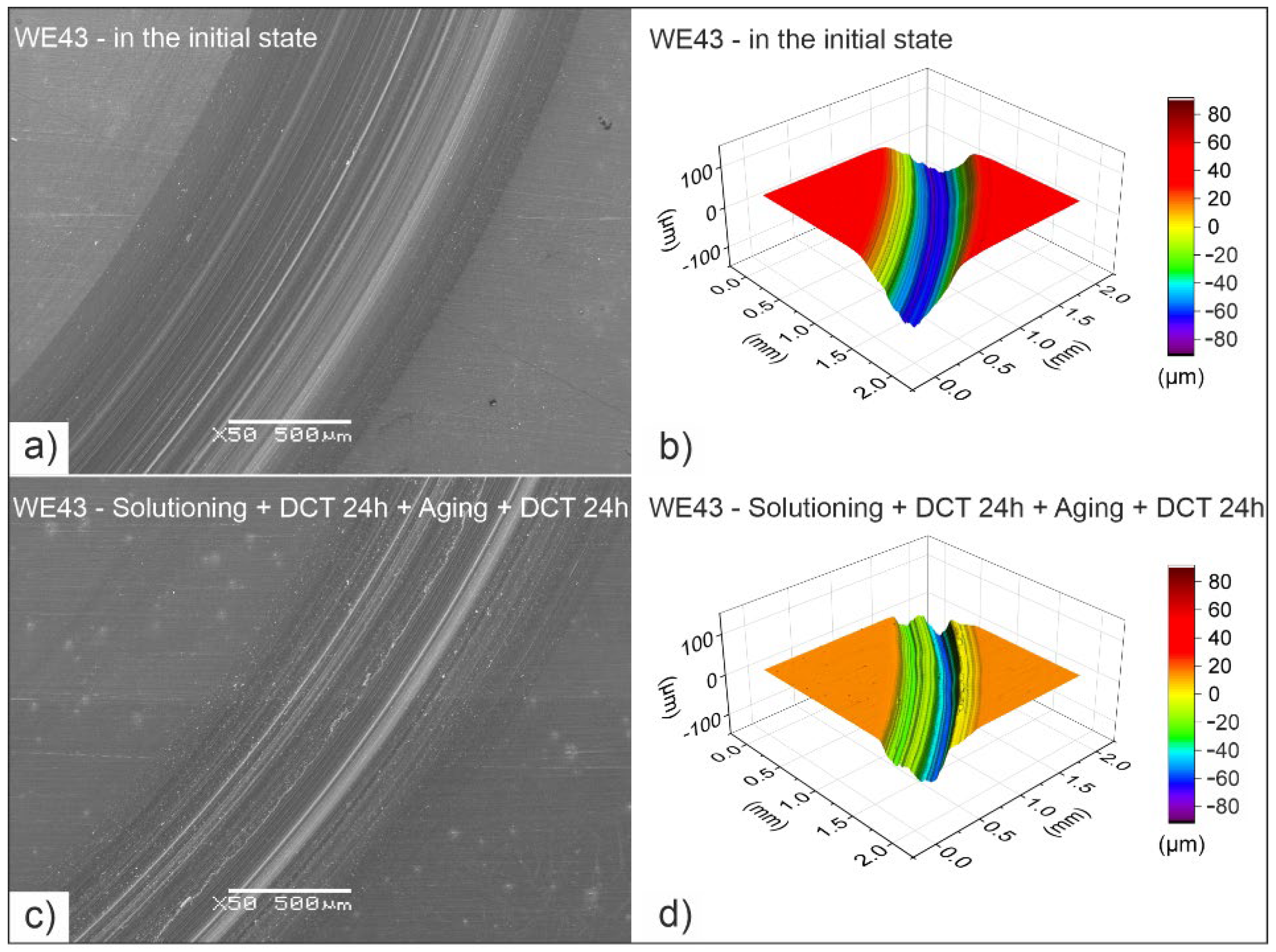

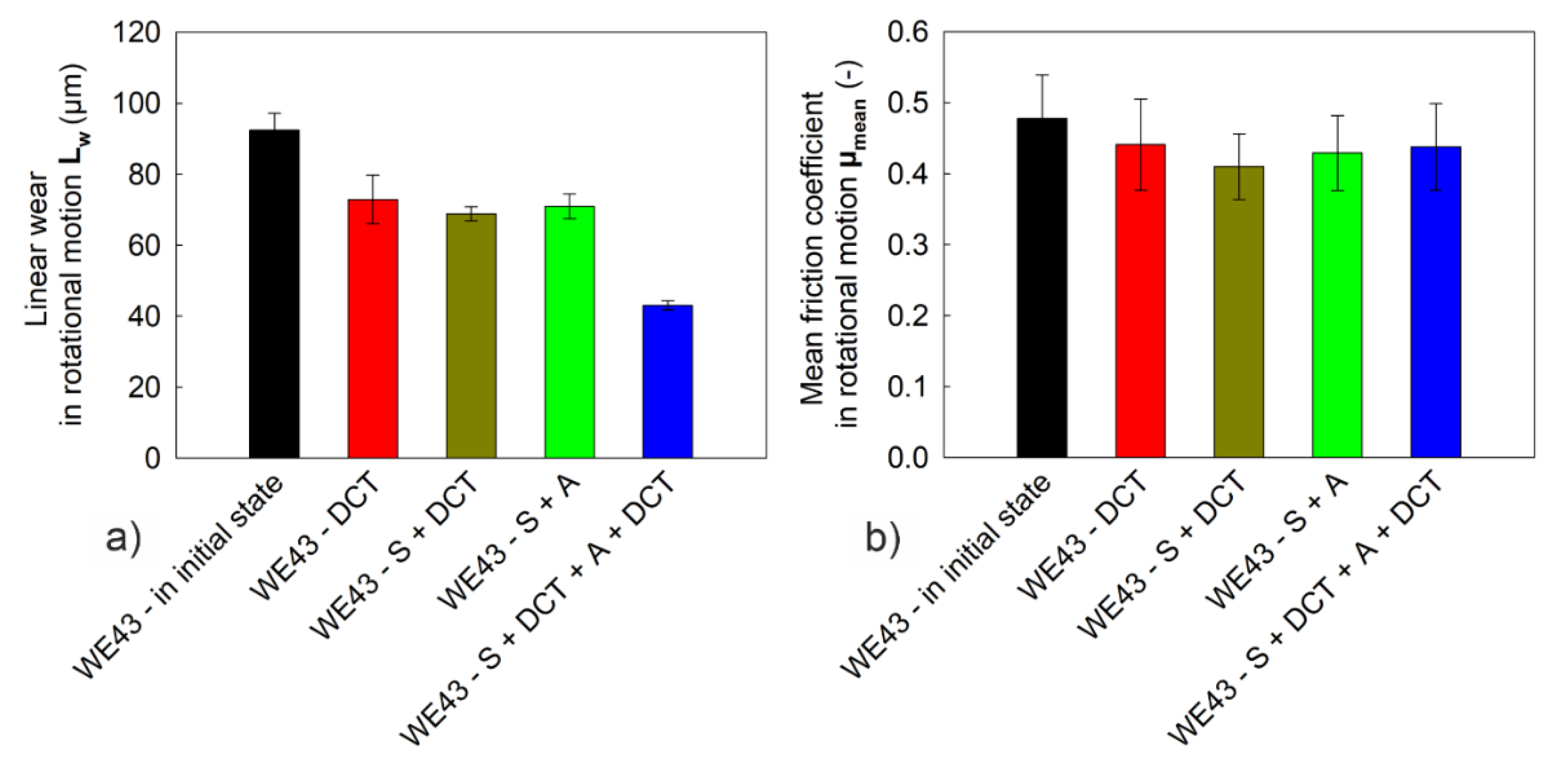


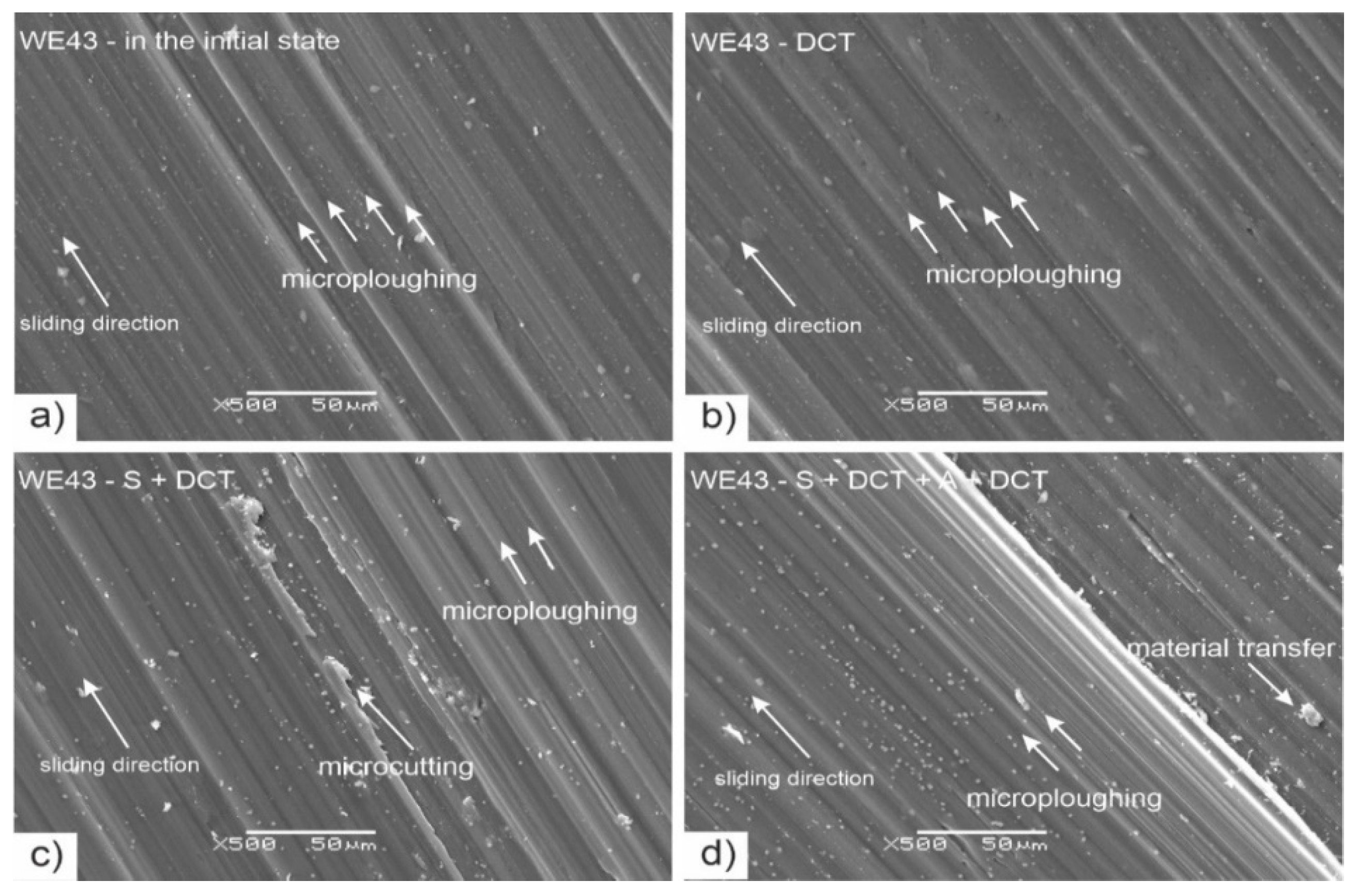
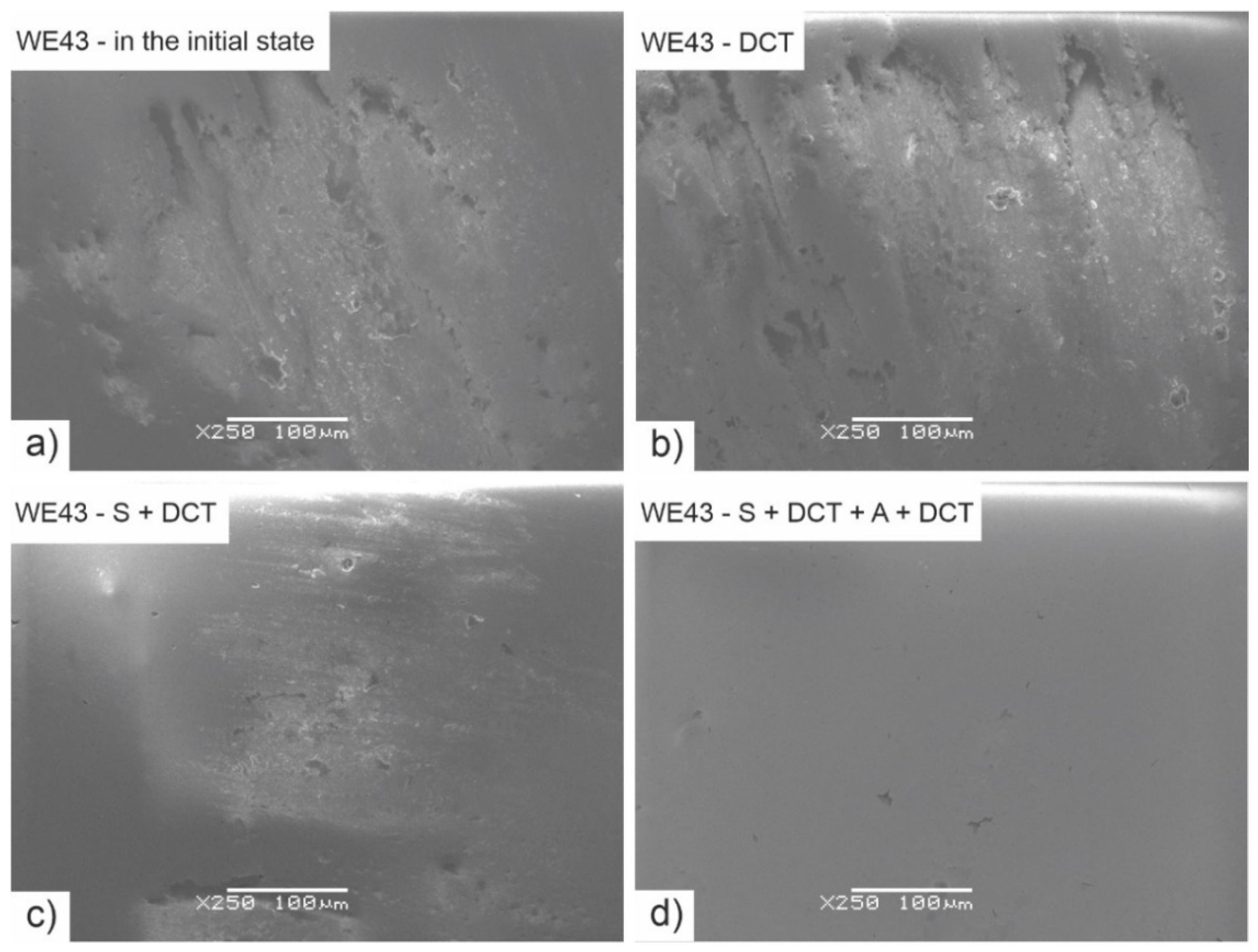
| Content of Components, wt.-% | |||||||
|---|---|---|---|---|---|---|---|
| Y | Nd | Zr | Zn | Mn | Cu | RE | Mg |
| 4.0 | 2.3 | 0.49 | 0.01 | 0.02 | 0.002 | 3.0 | residue |
| Sample | Heat Treatment Applied | |||
|---|---|---|---|---|
| Solution Treatment | Deep Cryogenic Treatment | Aging | Deep Cryogenic Treatment | |
| WE43 in initial state | - | - | - | - |
| WE43–DCT | - | −196 °C/24 h | - | - |
| WE43–S + DCT | 545 °C/8 h | −196 °C/24 h | - | - |
| WE43–S + A | 545 °C/8 h | - | 250 °C/24 h | - |
| WE43–S + DCT + A + DCT | 545 °C/8 h | −196 °C/24 h | 250 °C/24 h | −196 °C/24 h |
Publisher’s Note: MDPI stays neutral with regard to jurisdictional claims in published maps and institutional affiliations. |
© 2021 by the authors. Licensee MDPI, Basel, Switzerland. This article is an open access article distributed under the terms and conditions of the Creative Commons Attribution (CC BY) license (https://creativecommons.org/licenses/by/4.0/).
Share and Cite
Barylski, A.; Aniołek, K.; Dercz, G.; Kowalewski, P.; Kaptacz, S.; Rak, J.; Kupka, M. Investigation of Micromechanical Properties and Tribological Behavior of WE43 Magnesium Alloy after Deep Cryogenic Treatment Combined with Precipitation Hardening. Materials 2021, 14, 7343. https://doi.org/10.3390/ma14237343
Barylski A, Aniołek K, Dercz G, Kowalewski P, Kaptacz S, Rak J, Kupka M. Investigation of Micromechanical Properties and Tribological Behavior of WE43 Magnesium Alloy after Deep Cryogenic Treatment Combined with Precipitation Hardening. Materials. 2021; 14(23):7343. https://doi.org/10.3390/ma14237343
Chicago/Turabian StyleBarylski, Adrian, Krzysztof Aniołek, Grzegorz Dercz, Piotr Kowalewski, Sławomir Kaptacz, Jan Rak, and Marian Kupka. 2021. "Investigation of Micromechanical Properties and Tribological Behavior of WE43 Magnesium Alloy after Deep Cryogenic Treatment Combined with Precipitation Hardening" Materials 14, no. 23: 7343. https://doi.org/10.3390/ma14237343
APA StyleBarylski, A., Aniołek, K., Dercz, G., Kowalewski, P., Kaptacz, S., Rak, J., & Kupka, M. (2021). Investigation of Micromechanical Properties and Tribological Behavior of WE43 Magnesium Alloy after Deep Cryogenic Treatment Combined with Precipitation Hardening. Materials, 14(23), 7343. https://doi.org/10.3390/ma14237343











